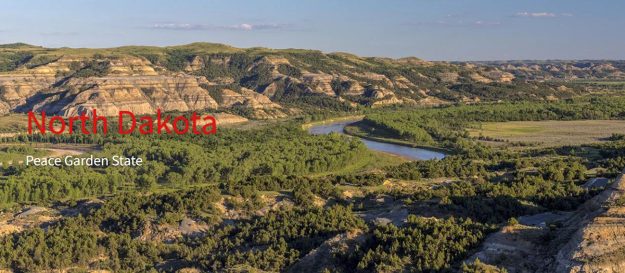Information North Dakota
North Dakota, abbreviation ND, is a state in the center of the north of the United States of America. The nickname for the State is “the Peace Garden State”. The state borders Canada on the north. The capital of North Dakota is Bismarck, but the largest city is Fargo. North Dakota is rich in natural resources, including oil.
North Dakota is especially suitable for tourists who love the rugged nature. The State has a number of beautiful nature parks, including Theodore Roosevelt National Park, where you can practice outdoor activities. However, from a historical point of view, North Dakota also has something to offer you as a tourist.
Geography
North Dakota is located on the border with Canada, in the north of the Great Plains. The state borders the states of Minnesota, South Dakota, and Montana and the Canadian provinces of Manitoba and Saskatchewan. The state measures a maximum of 580 kilometers from west to east and 340 kilometers from north to south. The main river is the Missouri River, which flows right through the county and is dammed by several large reservoirs, including Lake Sharpe, Lake Oahe, and Lake Sakakawea. The Red River forms the border with Minnesota and flows north into Canada. The Devils Lake is a larger lake in the north of the state.
The state is almost uniformly flat, there are hardly any areas with significant height differences. In terms of nature, the valley of the Little Missouri River in the west of the state is the most beautiful, with about 200 meters in elevation and so-called ‘Badlands’, an eroded landscape. This is where Theodore Roosevelt National Park is located. The highest point in North Dakota is the 1,069-foot White Butte. The site rises westward from 250 to 1,000 meters.
There is not really a clear transition from the classic Great Plains to the High Plains, the landscape gradually dries out towards the west. Most often, the Missouri River valley is used as a dividing line. The state has hardly any forest areas, the landscape consists of agricultural areas in the east, which changes into rangeland and ranchland in the west.
History
In 1738, Pierre de la Vérendrye was the first white person to penetrate this area. At the end of the 18th century, some Englishmen followed, employed by the Hudson Bay Company. Lewis and Clark wintered in 1804/1805 with the Mandan Indians on the upper Missouri. In 1818 the boundary between the American and English territories was established and North Dakota was organized as a territory, in 1889 it was accepted as the 39th state of the Union.
The opposition of trappers and Indians had long held up colonization; only after the Civil War did some immigration begin. The provisions in the so-called Homestead Act resulted in many farmers settling in the state, especially in the period 1875–1890. The economy suffered greatly from the Great Depression in the 1930s, but recovered during and after World War II. An important impulse was oil and gas extraction, which started in the 1950s but developed mainly as a result of the oil crisis (1973). North Dakota suffered heavy damage during the floods in 1993.
Economy
North Dakota is largely an agricultural state, but the massive growth in oil and gas production in the western part of the state made North Dakota the fastest growing state in the United States for several years in a row, both in population and economy. The state has weathered the recession the best since 2008 and for a long time had the lowest unemployment rate in the country.
Shale gas is extracted on a large scale in the state. Oil was discovered in North Dakota in 1951, and most of this is in the Bakken Formation, which is part of Montana and Canada. The Bakken Formation has potentially huge oil reserves, but only part of this is economically and technically recoverable. Western North Dakota also has large reserves of lignite, and the state is the second largest producer of lignite in the United States.
The city of Fargo is economically the dominant city in North Dakota and has a large catchment area well into Minnesota. Traditionally, Fargo’s economy was based on agriculture, but this share has fallen dramatically. In particular, the government and semi-government is strongly represented in Fargo.
| Abbreviation: | ND |
| Nickname: | Peace Garden State |
| Joined the US as the 39th state on: | 2 november 1889 |
| Capital city: | Bismarck |
| Census: | 683.932 |
| Surface: | 183.272 km² |
| Geography: | Bordering Canada, Minnesota, South Dakota, and Montana |
| Governor: | Doug Burgum |
| state motto: | Liberty and union now and forever, one and inseparable |
| California official website: | nd.gov |

